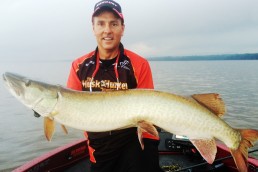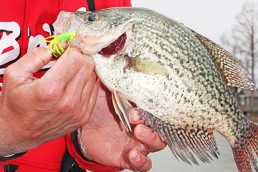Walking the Line of Muskie Success, or Failure
SHARE THIS POST
I can’t believe we faced another cold spring; it seems we just can’t get a break. I am really not a fan of the groundhog! Yet, before we know it we will be on the water for our first early season muskie trip with high hopes. However, it’s a fine line between success and failure. Early season is often feast or famine. You can work hard all day, just as you would in the summer, but there is a wild card that can impact your success unlike any other time of year—the elements. With the ecosystem in its infancy early in the season and water temperatures still cold, but on the rise, there are a lot of other factors beside spot and lure selection that determine your muskie results. Three things that I place at the top of my list on any spring muskie trip are: water temperature, water clarity and wind. These are three factors that change throughout the spring from day to day, and overall significantly from early to late spring. Likewise, there isn’t anything you can do to change these factors. So, my advice is to learn to work with them, or avoid the negative consequences often caused by them, to catch more muskies.
Water temperature is more important in spring than any other time of the year. I am talking about surface water temperatures. Certainly, the water temperatures below the first foot or so are always cold in spring, but the surface temperatures can warm significantly during the day. A cove, wind protected bay or channel could have 58-degree water in the morning, but that same area may have water temperatures in the 63-degree range by 2 p.m. This subtle warming is significant. I’ll often avoid shallow, wind-protected areas early in the morning, since the surface temperature can drop if the previous night was cold, and wait and fish them until around noon.
It is important to locate areas where the temperature is overall warmer and fish those areas where the water temperatures are on the rise. Sometimes different arms or coves of a reservoir will have areas that are 3 to 5 degrees warmer than others, so I’ll focus in those areas first. Sometimes in clearer reservoirs, an incoming creek with dark water can be warmer and the back of a cove can be warmer and hold more active muskies. Also, don’t ignore wind direction, as it can also impact your water temperature. It can blow either warm or cold surface temperatures into an area, turning fish on and off for no other apparent reason.

Water clarity is the key to your success in many waters. There are some waters I fish where the water is so clear you are looking for some slightly dingy water that is warmer and also increases your odds of a muskie making a mistake and biting your lure.
In other situations, the water may be dark and you are looking for slightly clearer water, so your lures are more visible and the fish have a greater chance in finding them. I think the one situation I am always avoiding is muddy water. Particularly, if the water is cold and muddy, avoid it like the plague.
Are you enjoying this post?
You can be among the first to get the latest info on where to go, what to use and how to use it!
A couple years back, one of my favorite early season reservoirs was very muddy early in the spring. Reports were that fishing was tough for weeks. Few if any muskies were being caught, by either casting or trolling. Yet, the lake is loaded with muskies and it was being fished by some excellent anglers. It was a classic situation of the water clarity being limited, combined with it being high that reduced the strike zone and just made it difficult to catch muskies. Fortunately, I kept postponing my trip while watching the weather. There was a four-day span of stable weather planned, so I booked my trip for that fourth day. By the time I arrived, the water clarity had improved significantly to the point where the fish were biting. I fished the same spots as other anglers did earlier, with the same lures, and the muskies were biting. It was just a matter of improved water clarity. Over the next week everyone who fished the water caught muskies. A classic lesson in: timing is everything.
Last, but not least of the elements to consider in spring is wind. It can be your friend or foe. Simply, warm winds are great, to some point, and cold winds are bad, most of the time. Generally, I don’t want super strong winds on a spring trip, as it tends to muddy the shallow water. I don’t mind calm and sunny days, as they tend to cause the shallows to warm. Given a preference, I prefer a slight wind that is southerly and warm. Northerly winds are usually going to cool things down. Wind direction will not only impact your particular day on the water, since strong winds can make boat control more difficult or reduce water clarity, but it can change the overall bite happening in an area.
If the winds are from the north, it could blow colder surface temperatures into an area and cause the surface temperature to drop and the bite to shut off. It may also cause portions of an area to cool, but concentrate warmer water in a smaller area, making the location of active muskies a little easier. A southerly wind might move warmer surface water into other areas, and make them turn-on later in the day or the next day.
All of these factors—water temperature, water clarity and wind—just require you to monitor them when you are on the water, and take a closer look at your map. It could be that a little map review will highlight an area where warmer or clearer water may be located. It could be that a wind-protected and fishable area may exist, to salvage the day. In any case, keep your mind on these things, as well as your favorite lures.
In summary, there are a few things you want to avoid on your next spring muskie trip: high, cold and muddy water, combined with strong wind. Keep that in mind when planning your early-season trips, particularly when looking over the map, before you go. It might mean rescheduling your trip, but the results are often well worth the change.
MWO
SHARE THIS POST
Did you enjoy this post?
You can be among the first to get the latest info on where to go, what to use and how to use it!
Jim Saric
Jim Saric is a Legendary Angler in the Freshwater Fishing Hall of Fame, the host and executive producer of The Musky Hunter television series, editor at large of Musky Hunter magazine, a seven-time muskie tournament winner, and a contributing writer for numerous other publications.



